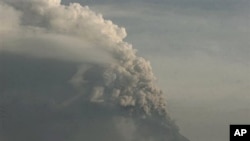The Indonesian government is keeping a close eye on Mount Merapi, as disaster management officials scramble to care for more than 270,000 people forced from their homes by the volcano. Nearly two weeks of eruptions have left more than 130 people dead.
Mount Merapi continues to spew hot clouds of gas and ash, reaching farther and farther from the summit.
Rescue workers say evacuees have been resettled at new camps after the government extended the evacuation zone from 20 kilometers on Friday, from the earlier 15-kilometer zone.
Tough living conditions
Some schools serve as shelters, but many evacuees are living beneath the stands at sports stadiums, while others are sleeping in tents in open fields. Relief workers say there is enough space for all the people, but they need more toilets and sanitation facilities.
Two weeks of living amid dust and ash has made breathing difficult for those closest to Merapi's summit. But Haris Eko Yulianto, head of the Indonesian Red Cross in Jogjakarta, says uncertainty is the biggest problem.
He says many people have colds, breathing problems and eye irritation. Basically they are just waiting until the government announces that it is safe for them to go back to their homes.
They could be waiting for weeks, since scientists monitoring the volcano predict that the eruptions will continue.
High alert
The government has the city of Yogyakarta, about 30 kilometers away the volcano, on high alert. Residents there have started leaving the city as ash falls, making life increasingly uncomfortable.
Disaster planning officials say thick mudflows have filled water runoff areas, which could lead to floods if it rains. They worry most about the rivers that run down the 3,000 meter-high mountain. The waterways could serve as conduits for pyroclastic flows, or hot gas clouds that carry searing heat and debris.
Those clouds reached villages that had not been evacuated on Friday, burning homes, livestock and people. On Monday television news broadcast the mass burial held for many of the victims killed since the eruptions started October 26.
Movie or reality?
Some Indonesians evoke comparisons to disaster movies. But Wisnu Wijaya, the head of disaster preparedness at Indonesia's Disaster Management Agency, says people far from the volcano have little to fear.
He says Yogyakarta and Solo are in safe positions. They are currently seeing a bit of ash rain, but the ash is blowing away from them, toward the southwest.
The U.S. Embassy says President Barack Obama still plans to arrive in Indonesia Tuesday evening as scheduled. The United States has offered $2 million to help Indonesia recover from the eruption and a tsunami that struck the west of the country last month. Indonesia's foreign minister, however, says the country is currently capable of handing the recovery on its own.









